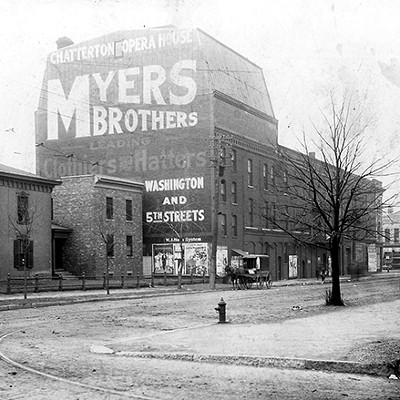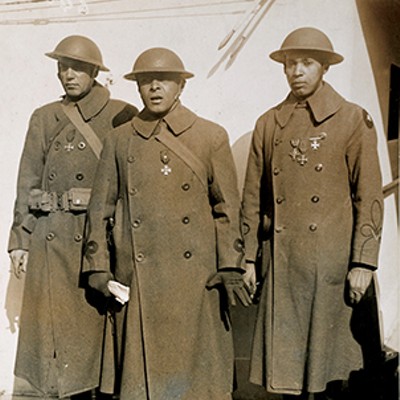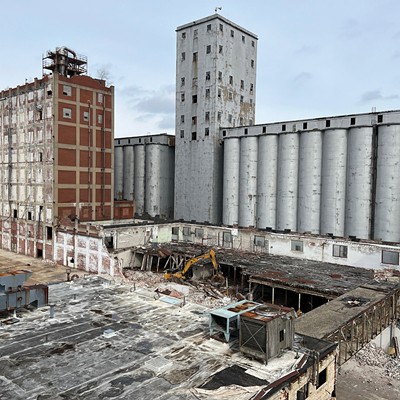His life today is simple and quiet. His days are spent in the tiny town of Fillmore, Ill., where he was born more than eight decades ago. But in an instant, Morgan Evans can return to another time, and to places all over the world, as part of a generation who gave up their innocence, and their lives, to help save the world as we know it.
For three years and three months during World War II, Seaman 1st Class Evans served on the U.S.S. Iowa. Not even six decades can touch his memories of that time — and Aug. 15, the 60th anniversary of V-J Day, gives Evans one more reason to reflect.
As a crew member aboard the Iowa, Evans would find himself stationed in Tokyo Bay on Sept. 2, 1945, at a climactic moment in history. He and his crewmates passed binoculars back and forth, straining to see the deck of the U.S.S. Missouri, where the formal Japanese signing of surrender terms took place, thus ending the World War II.
The mood on the Iowa was “pretty solemn,” recalls Evans. “We were just glad it was over.”
Morgan Evans witnessed the war’s end; his older brother Paul perished at the very beginning. Seaman 1st Class Paul Evans was aboard the U.S.S. Arizona in Pearl Harbor on Dec. 7, 1941. He was among the 1,177 who died on that battleship during the surprise Japanese attack.
Morgan Evans was still in high school when his brother died. The tragedy stopped time for him.
“I never studied another day in school,” he says.
“I would just sit and look out the window. I had no spirit.” His spirit remains wounded, his tears fresh, more than 60 years later.
Evans remembers his older brother as feisty and fearless.
“He was a small guy but not afraid of anything,” he says.
Driven by Paul’s death, Evans sought out the military himself, following in the footsteps of four older brothers: John, Kenneth, Paul, and James. At the age of 18 and all of 120 pounds, Morgan Evans joined the Navy.
With one son lost and four more given up to active duty, a restful night must have been a rarity at the Evans homestead. “Mom worried all the time, and she prayed all the time,” Evans remembers. Her faith was surely tested as she watched her fifth boy go off to war.
Fresh from the farmlands of Illinois, Evans arrived in New York City early in 1943 after completing basic training in his home state. As he took in a skyline unlike any he had seen, he did not know he would become one of 3,000 sailors aboard the U.S.S. Iowa and see things Fillmore could not have prepared him for.
Evans became part of the crew that commissioned the Iowa, the first battleship of its class. As part of the “shakedown,” they would push the ship to its limits, simultaneously firing all of the guns and pressing the ship to its top speed of 33 knots — all to ensure that it was fit for open waters, and war.
The Iowa would become his new home, and to this day Evans can fondly recall most any detail about his life there, from momentous missions to amusing anecdotes, such as the hazing that takes place at the crossing of the equator, when new sailors are unofficially — and unceremoniously — upgraded from “pollywogs” to “shellbacks.”
The young sailor’s duties included cleaning the sides of the 45,000-ton ship, all the way down to the waterline. As he worked his way down with a crewmate on a small scaffold hung by ropes, the water below — and the potentially soft landing it offered — was the only thing that eased his fear of heights.
As they made their way south along the East Coast, Evans remembers, the salty sailors were sometimes less than welcome, even in their stateside ports of call.
“You would see signs that said, ‘Sailors and dogs keep off the grass,’ ” Evans recalls. Yet these rough-and-tumble sailors would be the very ones to serve as a presidential escort for a historic meeting.
In November 1943, the U.S.S. Iowa picked up President Franklin D. Roosevelt and several top-ranking military officials in Virginia and carried them across the Atlantic for secret meetings with the likes of Josef Stalin and Winston Churchill. The crew would later learn of a frightening near-miss in which an American torpedo was mistakenly fired at the Iowa as it carried the president and his joint chiefs. Fortunately, the missile exploded harmlessly in the Iowa’s massive wake.
After this important mission, the Iowa made its way to the Pacific, by way of the side-scraping Panama Canal, and began bombarding the Marshall Islands and other targets, including the Philippines.
“We would soften it up for the soldiers who went in,” says Evans.
The Iowa eventually made its way to the coast of Japan, where, Evans recalls, “we would go in at midnight and try to hit the factories.”
The ship’s travels were slow, Evans says, because of the continuous need for evasive tactics. “When we were at sea, we were on a zigzag course all the time.”
But there would be no evading a danger of a different sort in December 1944, as 200 ships, including the Iowa, gathered in open water to refuel off the coast of Luzon. Winds in excess of 100 knots began whipping the ocean into a frenzy, and soon the ships found themselves caught in a terrifying typhoon.
Visibility was reduced to a mere 3 feet, and “the waves were 125 feet high,” Evans recalls. “We were taking water on the main deck.”
“The force threw a guy on our ship against the bulkhead and killed him,” recalls Evans. “It was scary.”
As the storm raged, “I didn’t think the ‘tin cans’ [destroyers] would come back up after they went under,” says Evans “but they always did” — all but three, that is.
The Iowa had just finished refueling, and several others were in the process, when fierce waves ripped loose the fuel hoses, leaving several ships without fuel and helpless against the water’s whims. In the end, three destroyers went down and hundreds of seamen who had eluded enemy fire were unable to escape the deadly grasp of the sea.
In the storm’s aftermath, the Iowa’s crew searched for bodies and, to their surprise, found a handful of survivors.
Evans and the Iowa eventually returned to Tokyo Bay, where they continued blasting the coast. Then, in early August 1945, they received orders to drop back 100 miles. At the time, the sailors did not understand the magnitude of what was to happen.
Evans remembers: “We were told they were going to do something that would mean no one could live in that area for 100 years.”
Hiroshima was the target of America’s first atomic bomb on Aug. 6, 1945. A second was dropped on the city of Nagasaki on Aug. 9, leading to the Japanese surrender.
From his viewpoint in the bay, Evans could see signs that the war’s end was near. “We saw all the Japanese submarines starting to come in.”
Not long after he and his buddies peered through those binoculars to witness the formal Japanese surrender, the Iowa crew offered food, shelter, and medical care to several hundred American prisoners of war, newly released by their Japanese captors. Each Iowa sailor was assigned a POW, whom he was expected to guide around the huge ship.
Evans was assigned to a Canadian soldier who had been captured in Hong Kong on Christmas Day 1941, just weeks after the war began. “They had him working in the coal mines,” Evans says. “He wasn’t in very good shape.”
The ship of the second POW assigned to Evans had sunk in the Atlantic. Through an unusual twist of fate, the unfortunate sailor found himself in the hands of the Germans, who later — for reasons unknown to him — handed him over to the Japanese.
“He was still throwing a fit about that,” says Evans, equally baffled by the young sailor’s strange journey.
The battered and crippled prisoners were the last of the war’s haunting sights to accompany Evans on his return to civilian life. In January 1946, just months after the war’s end, Evans was released from the Navy.
This sailor, and many like him, went from living in a war zone — daily witnesses to death and destruction — to “normal” life at a speed that was unsettling.
Looking back, Evans believes that professional counseling would have made the transition smoother. As it was, left abruptly on his own, Evans often sought out the bottle as a remedy for coping. (Years later, though, on his mother’s passing, Evans would be inspired to quit drinking and smoking.)
After a lifetime working as a laborer, including a decade on a railroad steel gang, Evans, 81, now lives quietly in his hometown. He has no regrets about his time in the Navy; it was the path he chose in following what he considered a patriotic duty.
World War II asked something of everyone, says Evans, and “everyone was loyal.” Young men were called to duty, families rationed food and goods, and women took on a new role working in factories to support the war and the economy back home. “Everybody’s life changed during the war.”
The experience was difficult to make sense of, says Evans. As a young man caught up in world events beyond his understanding, he says, “I never could realize what it’s all about.”
Evans says that he did not fear death, though it was all around him. “I never gave it a thought,” he says, “Whatever happens, happens.”
The war, and the U.S.S. Iowa, left a large wake, and Evans’ memories of that time are never far from reach. In vivid detail, he is able to go back to scenes that are nothing short of epic.
He doesn’t mind sharing a glance into his past.
“If nobody knows it, it’s gone,” he says.






















